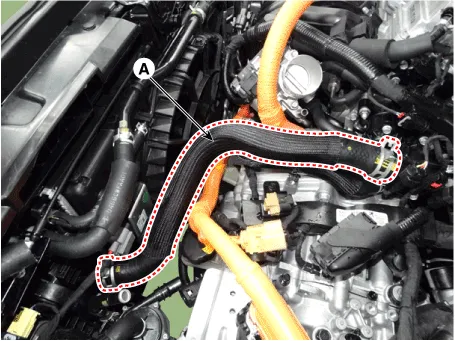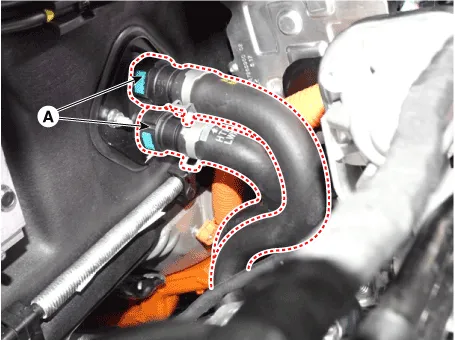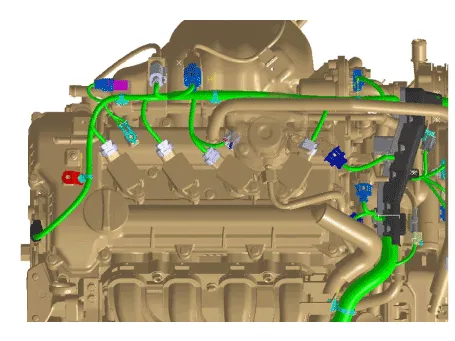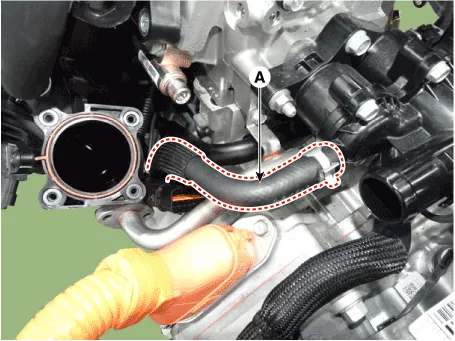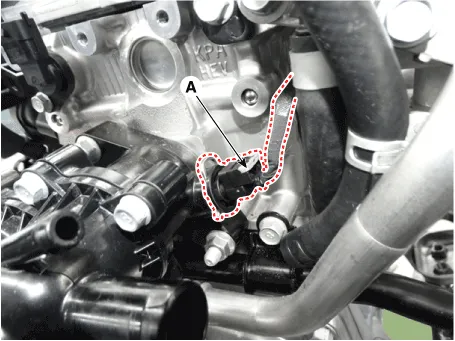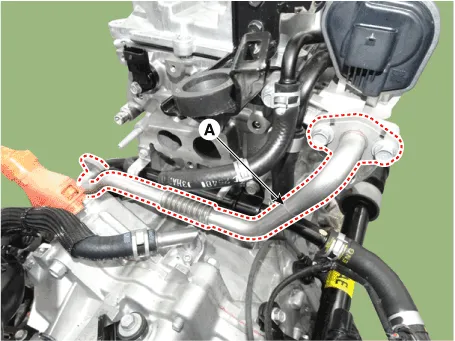Hyundai Ioniq (AE): Cooling System / Water Temperature Control Assembly. Repair procedures
| Removal and installation |
| 1. | Disconnect the battery negative terminal. |
| 2. | Loosen the drain plug, and drain the engine coolant. Remove the reservoir cap to help drain the coolant faster. (Refer to Cooling System - "Coolant") |
| 3. | Remove the air cleaner assembly. (Refer to Intake and Exhaust System - "Air Cleaner") |
| 4. | Disconnect the radiator upper hose (A).
|
| 5. | Disconnect the heater hoses (A).
|
| 6. | Disconnect the wiring connectors and harness clamps and remove the connector brackets around the water temperature control assembly.
|
| 7. | Disconnect the degassing hose (A) and EGR cooler hose (B).
|
| 8. | Disconnect the oil cooler hose (A).
|
| 9. | Disconnect the water temperature sensor connector (A).
|
| 10. | Remove the water temperature control assembly (A).
|
| 11. | Install in the reverse order of removal. |
| 1. | Disconnect the battery negative terminal. |
| 2. | Loosen the drain plug, and drain the engine coolant. Remove the reservoir cap to help drain the coolant faster. (Refer to Cooling System - "Coolant") |
| 3. | Remove the air cleaner assembly. (Refer to Intake and Exhaust System - "Air Cleaner") |
| 4. | Remove the water temperature control assembly. (Refer to Cooling System - "Water Temperature Control Assembly") |
| 5. | Remove the intake manifold. (Refer to Intake and Exhaust System - "Intake Manifold") |
| 6. | Remove the electric EGR control valve cooler pipe (A).
|
| 7. | Remove the heater pipe (A).
|
| 8. | Install in the reverse order of removal. |
| 9. | Fill the radiator with coolant and check for leaks. (Refer to Cooling System - "Coolant") |
| 10. | Start engine and check for leaks. |
| 11. | Recheck the coolant level. |
| Inspection |
| 1. | Remove the outlet fitting, coolant temperature sensor, bracket and gasket from the coolant temperature control assembly. |
| 2. | Submerge the coolant temperature control assembly with the thermostat in the antifreeze and heat the antifreeze slowly.
|
| 3. | Check the valve opening temperature.
If the valve opening temperature is not as specified, replace the thermostat. |
| 4. | Check the valve lift.
If the valve lift is not as specified, replace the thermostat. |
Components1. Water temperature control (WTC) outlet fitting2. Water temperature control (WTC) housing3. Water temperature control (WTC) gasket4. Water temperature control (WTC) outlet fitting gasket5.
Components1. Water pump pulley2. Water pump3. Gasket
Other information:
Hyundai Ioniq (AE) 2017-2022 Service & Repair Manual: In-car Sensor. Repair procedures
Diagnosis With GDS1.The heating, ventilation and air conditioning can be quickly diagnosed failed parts with vehicle diagnostic system (GDS).※ The diagnostic system (GDS) provides the following information.(1) Self diagnosis : Checking the failure code (DTC) and display.
Hyundai Ioniq (AE) 2017-2022 Service & Repair Manual: Schematic diagrams
System Block DiagramComponent Parts and Function Outline Component part Function Vehicle-speed sensor, ESP/ABS Control ModuleConverts vehicle speed to pulse.VCUReceives signals from sensor and control switches.
Categories
- Manuals Home
- Hyundai Ioniq Owners Manual
- Hyundai Ioniq Service Manual
- USB jack. Repair procedures
- Audio Remote Control. Components and components location
- Audio Remote Control. Schematic diagrams
- New on site
- Most important about car

